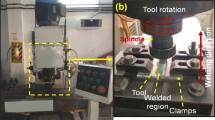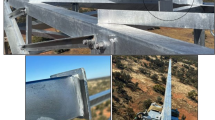Abstract
During tandem cold rolling mill process, strip tearing reduces production rate, damages the rollers, and consequently decreases efficiency of production. Predicting and postponing of this phenomenon leads to less expensive trial and errors in rolling industries. In this research first, DIN1623 St12 steel which is frequently applied in metal forming industries and also Bao–Wierzbicki ductile damage criterion is selected. Then, six curve fitting methods are employed to calibrate the material and are presented in 2D space of equivalent plastic strain to fracture and stress triaxiality. Finally, the achieved fracture loci are validated by comparing corresponding simulation results with experimental tests and the best curve fitting method with aims of high accuracy for tracking the strip tearing in a tandem cold rolling mill process and fewer numbers of required tests is revealed. Eventually, due to engaging this innovative approach, it is possible to trace the strip tearing in tandem cold rolling mill process by performing only two simple tensile tests. Therefore, it is concluded that strip tearing phenomenon can be precisely predicted in tandem cold rolling mill processes by a special focus on calibration of the Bao–Wierzbicki damage criterion in the range of low positive stress triaxiality which causes less number of needed tests.
























Similar content being viewed by others

Abbreviations
- \(c,c_{1} ,c_{2}\) :
-
Damage parameters
- \(d_{1} ,d_{2} ,d_{3} ,d_{4}\) :
-
Damage parameters
- \(D\) :
-
Damage variable
- \(e_{u}\) :
-
Elongation
- \(E\) :
-
Young’s modulus
- \(K\) :
-
Hardening coefficient
- \(n\) :
-
Hardening power
- \(u_{{\text{f}}}\) :
-
Displacement to fracture
- \(\varepsilon_{{{\text{eq}}}}\) :
-
Equivalent plastic strain
- \(\varepsilon_{{\text{f}}}\) :
-
Equivalent fracture strain at onset of fracture
- \(\varepsilon_{{{\text{f}},{\text{s}}}}\) :
-
Equivalent fracture strain under pure shear
- \(\varepsilon_{{{\text{f}},{\text{t}}}}\) :
-
Equivalent fracture strain under uniaxial tension
- \(\eta\) :
-
Stress triaxiality
- \(\eta_{0}\) :
-
Intersection point of the second and third branches of fracture locus
- \(\sigma_{1}\), \(\sigma_{2}\), \(\sigma_{3}\) :
-
Principal stresses
- \(\sigma_{{{\text{eq}}}}\) :
-
Von Mises equivalent stress
- \(\sigma_{{\text{m}}}\) :
-
Mean stress
- \(\sigma_{{\text{u}}}\) :
-
Ultimate stress
- \(\sigma_{{y_{0} }}\) :
-
Initial yield stress
References
Mohr, D., Henn, S.: Calibration of stress-triaxiality dependent crack formation criteria: a new hybrid experimental–numerical method. Exp. Mech. 47(6), 805–820 (2007)
Lemaitre, J.: A Course on Damage Mechanics. Springer, Berlin (1996)
Gurson, A.L.: Continuum theory of ductile rupture by void nucleation and growth: part I- yield criteria and flow rules for porous ductile media. J. Eng. Mater. Technol. 99, 2–15 (1977)
Chu, C., Needleman, A.: Void nucleation effects in biaxially stretched sheets. J. Eng. Mater. Technol. 102, 249–256 (1980)
Needleman, A., Tvergaard, V.: An analysis of ductile rupture in notched bars. J. Mech. Phys. Solids 32(6), 461–490 (1984)
Gologanu, M., Leblond, J.B., Devaux, J.: Approximate models for ductile metals containing non-spherical voids—case of axisymmetric prolate ellipsoidal cavities. J. Mech. Phys. Solids 41(11), 1723–1754 (1993)
Garajeu, M., Michel, J., Suquet, P.: A micromechanical approach of damage in viscoplastic materials by evolution in size, shape and distribution of voids. Comput. Methods Appl. Mech. Eng. 183(3–4), 223–246 (2000)
Pardoen, T., Hutchinson, J.: An extended model for void growth and coalescence. J. Mech. Phys. Solids 48(12), 2467–2512 (2000)
Benzerga, A., Besson, J., Pineau, A.: Anisotropic ductile fracture: part II: theory. Acta Mater. 52(15), 4639–4650 (2004)
Ruzicka, J., Spaniel, M., Prantl, A., Dzugan, J., Kuzelka, J., Moravec, M.: Identification of ductile damage parameters in the Abaqus. Bull. Appl. Mech. 8, 89–92 (2012)
McClintock, F.A.: A criterion for ductile fracture by the growth of holes. J. Appl. Mech. 35(2), 363–371 (1968)
Rice, J.R., Tracey, D.M.: On the ductile enlargement of voids in triaxial stress fields. J. Mech. Phys. Solids 17(3), 201–217 (1969)
Cockcroft, M., Latham, D.: Ductility and the workability of metals. J. Inst. Met. 96(1), 33–39 (1968)
Brozzo, P., Deluca, B., Rendina, R.: A new method for the prediction of formability limits in metal sheets. Sheet Metal Forming and Formability. In: Proceedings of the 7th Biennial Conference of the International Deep Drawing Research Group (1972)
Clift, S.E., Hartley, P., Sturgess, C., Rowe, G.: Fracture prediction in plastic deformation processes. Int. J. Mech. Sci. 32(1), 1–17 (1990)
Lemaitre, J.: A continuous damage mechanics model for ductile fracture. J. Eng. Mater. Technol. 107, 83–89 (1985)
Johnson, G.R., Cook, W.H.: Fracture characteristics of three metals subjected to various strains, strain rates, temperatures and pressures. Eng. Fract. Mech. 21(1), 31–48 (1985)
Hooputra, H., Gese, H., Dell, H., Werner, H.: A comprehensive failure model for crashworthiness simulation of aluminium extrusions. Int. J. Crashworth. 9(5), 449–464 (2004)
Haji Aboutalebi, F., Banihashemi, A.: Numerical estimation and practical validation of Hooputra’s ductile damage parameters. Int. J. Adv. Manuf. Technol. 75(9–12), 1701–1710 (2014)
Bao, Y., Wierzbicki, T.: On fracture locus in the equivalent strain and stress triaxiality space. Int. J. Mech. Sci. 46(1), 81–98 (2004)
Bao, Y., Wierzbicki, T.: On the cut-off value of negative triaxiality for fracture. Eng. Fract. Mech. 72(7), 1049–1069 (2005)
Bao, Y., Wierzbicki, T.: Determination of fracture locus for the 2024T351 aluminum. Impact and Crashworthiness Laboratory, Report No. 81 (2002)
Bao, Y., Bai, Y., Wierzbicki, T.: Calibration of A710 steel for fracture. Massachusetts Institute of Technology, Impact and Crashworthiness Laboratory Report No. 135 (2004)
Lee, Y., Wierzbicki, T.: Quick fracture calibration for industrial use, Report No: 115. Impact and crashworthiness laboratory, Massachusetts Institute of Technology (2004)
Jeong, D., Yu, H., Gordon, J., Tang, Y.: Finite element analysis of unnotched Charpy impact tests. In: Proceedings of the Materials Science and Technology 2008 Conference and Exhibition (2008)
Kacem, A., Krichen, A., Manach, P.-Y., Thuillier, S., Yoon, J.W.: Failure prediction in the hole-flanging process of aluminium alloys. Eng. Fract. Mech. 99, 251–265 (2013)
Yu, H., Jeong, D.: Application of a stress triaxiality dependent fracture criterion in the finite element analysis of unnotched Charpy specimens. Theor. Appl. Fract. Mech. 54(1), 54–62 (2010)
Haji Aboutalebi, F., Poursina, M., Nejatbakhsh, H., Khataei, M.: Numerical simulations and experimental validations of a proposed ductile damage model for DIN1623 St12 steel. Engineering Fracture Mechanics, vol. 192, pp. 276–289 (2018)
Brunig, M., Gerke, S., Schmidt, M.: Damage and failure at negative stress triaxialities: experiments, modeling and numerical simulations. Int. J. Plast. 102, 70–82 (2018)
Gerke, S., Zistl, M., Bhardwaj, A., Brunig, M.: Experiments with the X0-specimen on the effect of non-proportional loading paths on damage and fracture mechanisms in aluminum alloys. Int. J. Solids Struct. 163, 157–169 (2019)
Pimenov, A., Abramov, A., Traino, A., Efremov, N.: Reduction in strip tearing during stopping and starting of a continuous cold-rolling mill. Metallurgist 31(4), 94–95 (1987)
Mashayekhi, M., Torabian, N., Poursina, M.: Continuum damage mechanics analysis of strip tearing in a tandem cold rolling process. Simul. Model. Pract. Theory 19(2), 612–625 (2011)
Poursina, M., Dehkordi, N.T., Fattahi, A., Mirmohammadi, H.: Application of genetic algorithms to optimization of rolling schedules based on damage mechanics. Simul. Model. Pract. Theory 22, 61–73 (2012)
Sun, Q., Zan, D.Q., Pan, H.L., Chen, J.J.: On the utilization of shear modified GTN damage model in cold rolling. Appl. Mech. Mater. 750, 47–50 (2015)
Wierzbicki, T., Bao, Y., Lee, Y.-W., Bai, Y.: Calibration and evaluation of seven fracture models. Int. J. Mech. Sci. 47(4–5), 719–743 (2005)
Bai, Y., Wierzbicki, T.: A new model of metal plasticity and fracture with pressure and Lode dependence. Int. J. Plast. 24(6), 1071–1096 (2008)
Bai, Y., Wierzbicki, T.: Application of extended Mohr–Coulomb criterion to ductile fracture. Int. J. Fract. 161(1), 1 (2010)
Bai, Y., Bao, Y., Wierzbicki, T.: Fracture of prismatic aluminum tubes under reverse straining. Int. J. Impact Eng. 32(5), 671–701 (2006)
Bai, Y., Teng, X., Wierzbicki, T.: On the application of stress triaxiality formula for plane strain fracture testing. J. Eng. Mater. Technol. 131(2), 1–10 (2009)
Mae, H., Teng, X., Bai, Y., Wierzbicki, T.: Calibration of ductile fracture properties of a cast aluminum alloy. Mater. Sci. Eng. A 459(1–2), 156–166 (2007)
ISO/IEC 17025 standard, general requirements for the competence of testing and calibration laboratories (2017)
Earl, J.C., Brown, D.K.: Distributions of stress and plastic strain in circumferentially notched tension specimens. Eng. Fract. Mech. 8(4), 599–611 (1976)
Isfahan Mobarakeh Steel Company Internal Reports—No. 48246991-1 (2009)
ibaAnalyzer Analysis Software Manual, issue 6.3, iba AG., Germany (2014)
Author information
Authors and Affiliations
Corresponding author
Ethics declarations
Conflict of interest
On behalf of all authors, the corresponding author states that there is no conflict of interest.
Additional information
Publisher's Note
Springer Nature remains neutral with regard to jurisdictional claims in published maps and institutional affiliations.
Rights and permissions
About this article
Cite this article
Asadi, M., Haji Aboutalebi, F. & Poursina, M. A comparative study of six fracture loci for DIN1623 St12 steel to predict strip tearing in a tandem cold rolling mill. Arch Appl Mech 91, 1859–1878 (2021). https://doi.org/10.1007/s00419-020-01859-0
Received:
Accepted:
Published:
Issue Date:
DOI: https://doi.org/10.1007/s00419-020-01859-0



